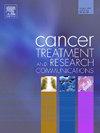Treatment refractoriness and response rates in patients with relapsed/refractory multiple myeloma: a retrospective analysis of real-world data
IF 2.4
Q3 Medicine
引用次数: 0
Abstract
Background
Significant advancements have been made in the management of multiple myeloma (MM); however, high relapse rates continue to worsen prognosis and reduce survival for many patients. This study aims to evaluate treatment refractoriness and response rates in individuals with relapsed and/or refractory MM using real-world evidence.
Methodology
A retrospective cohort study utilizing commercial registry data for 2022, included individuals with relapsed and/or refractory MM who are 18–79 years old and obtain minimum of 5 lines of therapy. Patients at least have one proteasome inhibitor (PI), an immunomodulatory drug (IMiD), and CD38-targeting monoclonal antibody (CD38 MoAB), with their last MM-related visit before October 2022. Patients were excluded if they had concurrent primary malignancies or documented death within 28 days of last line of treatment initiation. Descriptive data, including patient demographic and clinical characteristics, were summarized using continuous and categorical variables.
Results
We identified 283 patients after applying inclusion and exclusion criteria. 35.7 % of patients have an overall response rate with median response duration of 6.3 months. Most of patients were found to be categorized in penta-refractory class (33.6 %), followed by triple-refractory (25.4 %), dual-refractory (19.4 %), and not triple-refractory classes (13.4 %). The response rate was 49.1% in dual-class refractory, 22.2 % in triple-class refractory, 44.7 % in not triple-class refractory, and 33.7 % in penta-class refractory patients.
Conclusion
Findings imply that substantial proportion of patients continue to show limited treatment response and treatment refractoriness even after multiple lines of therapy.
复发/难治性多发性骨髓瘤患者的治疗难治性和缓解率:对现实世界数据的回顾性分析
背景:在多发性骨髓瘤(MM)的治疗方面取得了重大进展;然而,高复发率继续恶化预后,减少许多患者的生存。本研究旨在利用真实世界的证据评估复发和/或难治性MM患者的治疗难治性和缓解率。方法一项回顾性队列研究,利用2022年的商业注册数据,纳入18-79岁的复发和/或难治性MM患者,并接受至少5种治疗。患者至少有一种蛋白酶体抑制剂(PI)、一种免疫调节药物(IMiD)和靶向CD38的单克隆抗体(CD38 MoAB),最后一次与mm相关的就诊是在2022年10月之前。如果患者同时患有原发性恶性肿瘤或在最后一条治疗线开始后28天内死亡,则排除。描述性数据,包括患者人口统计学和临床特征,使用连续变量和分类变量进行总结。结果采用纳入和排除标准,筛选出283例患者。35.7%的患者总体缓解率,中位缓解持续时间为6.3个月。大多数患者被归类为五难治性(33.6%),其次是三难治性(25.4%)、双难治性(19.4%)和非三难治性(13.4%)。两级难治的有效率为49.1%,三级难治的有效率为22.2%,非三级难治的有效率为44.7%,五级难治的有效率为33.7%。结论研究结果表明,相当比例的患者在多次治疗后仍然表现出有限的治疗反应和治疗难治性。
本文章由计算机程序翻译,如有差异,请以英文原文为准。
求助全文
约1分钟内获得全文
求助全文
来源期刊

Cancer treatment and research communications
Medicine-Oncology
CiteScore
4.30
自引率
0.00%
发文量
148
审稿时长
56 days
期刊介绍:
Cancer Treatment and Research Communications is an international peer-reviewed publication dedicated to providing comprehensive basic, translational, and clinical oncology research. The journal is devoted to articles on detection, diagnosis, prevention, policy, and treatment of cancer and provides a global forum for the nurturing and development of future generations of oncology scientists. Cancer Treatment and Research Communications publishes comprehensive reviews and original studies describing various aspects of basic through clinical research of all tumor types. The journal also accepts clinical studies in oncology, with an emphasis on prospective early phase clinical trials. Specific areas of interest include basic, translational, and clinical research and mechanistic approaches; cancer biology; molecular carcinogenesis; genetics and genomics; stem cell and developmental biology; immunology; molecular and cellular oncology; systems biology; drug sensitivity and resistance; gene and antisense therapy; pathology, markers, and prognostic indicators; chemoprevention strategies; multimodality therapy; cancer policy; and integration of various approaches. Our mission is to be the premier source of relevant information through promoting excellence in research and facilitating the timely translation of that science to health care and clinical practice.
 求助内容:
求助内容: 应助结果提醒方式:
应助结果提醒方式:


